Shahram Shahbazpanahi
Handoffs in User-Centric Cell-Free MIMO Networks: A POMDP Framework
Mar 13, 2024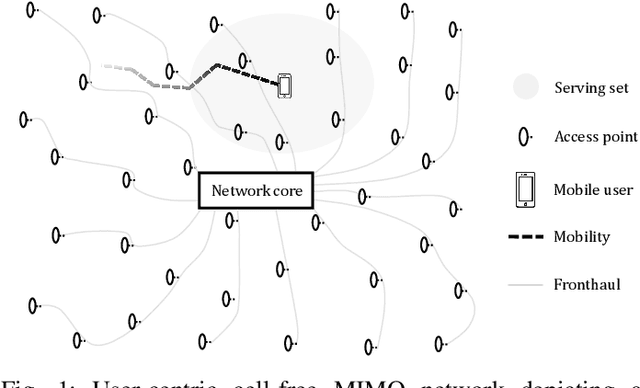
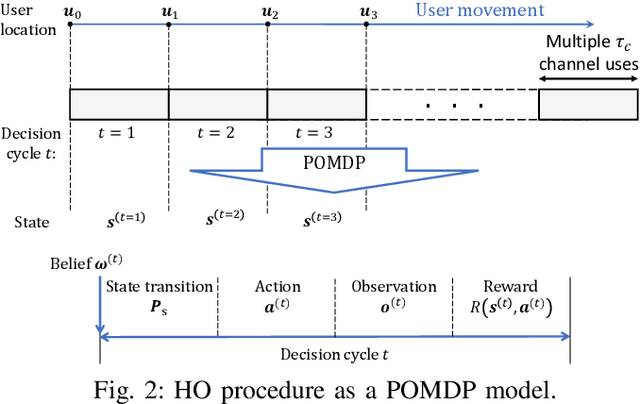
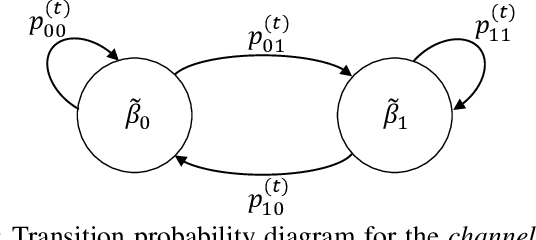
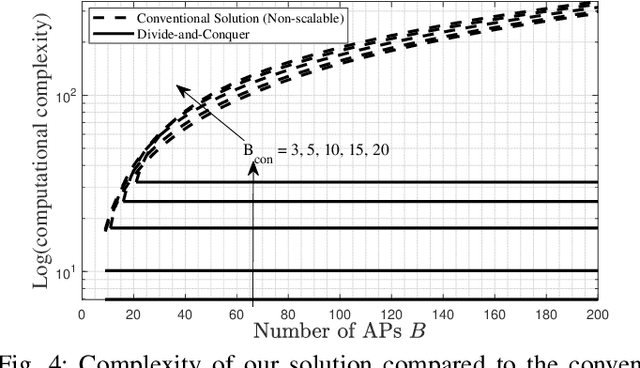
Abstract:We study the problem of managing handoffs (HOs) in user-centric cell-free massive MIMO (UC-mMIMO) networks. Motivated by the importance of controlling the number of HOs and by the correlation between efficient HO decisions and the temporal evolution of the channel conditions, we formulate a partially observable Markov decision process (POMDP) with the state space representing the discrete versions of the large-scale fading and the action space representing the association decisions of the user with the access points (APs). We develop a novel algorithm that employs this model to derive a HO policy for a mobile user based on current and future rewards. To alleviate the high complexity of our POMDP, we follow a divide-and-conquer approach by breaking down the POMDP formulation into sub-problems, each solved separately. Then, the policy and the candidate pool of APs for the sub-problem that produced the best total expected reward are used to perform HOs within a specific time horizon. We then introduce modifications to our algorithm to decrease the number of HOs. The results show that half of the number of HOs in the UC-mMIMO networks can be eliminated. Namely, our novel solution can control the number of HOs while maintaining a rate guarantee, where a 47%-70% reduction of the cumulative number of HOs is observed in networks with a density of 125 APs per km2. Most importantly, our results show that a POMDP-based HO scheme is promising to control HOs.
POMDP-based Handoffs for User-Centric Cell-Free MIMO Networks
Aug 07, 2022
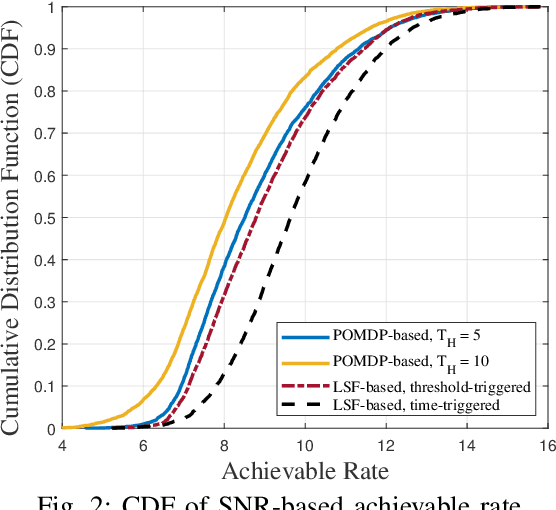
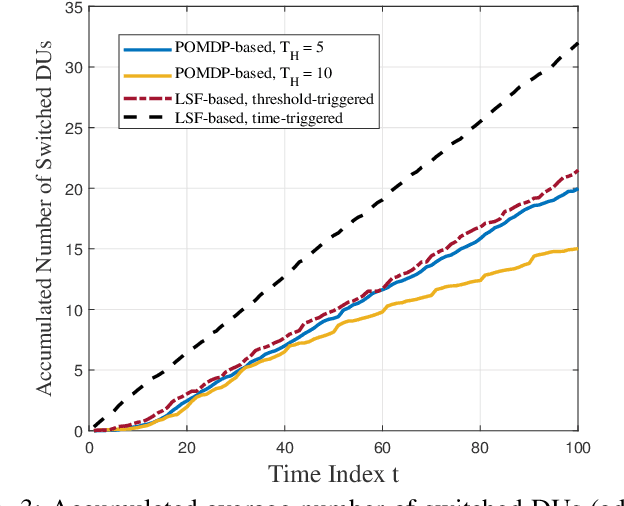

Abstract:We propose to control handoffs (HOs) in user-centric cell-free massive MIMO networks through a partially observable Markov decision process (POMDP) with the state space representing the discrete versions of the large-scale fading (LSF) and the action space representing the association decisions of the user with the access points. Our proposed formulation accounts for the temporal evolution and the partial observability of the channel states. This allows us to consider future rewards when performing HO decisions, and hence obtain a robust HO policy. To alleviate the high complexity of solving our POMDP, we follow a divide-and-conquer approach by breaking down the POMDP formulation into sub-problems, each solved individually. Then, the policy and the candidate cluster of access points for the best solved sub-problem is used to perform HOs within a specific time horizon. We control the number of HOs by determining when to use the HO policy. Our simulation results show that our proposed solution reduces HOs by 47% compared to time-triggered LSF-based HOs and by 70% compared to data rate threshold-triggered LSF-based HOs. This amount can be further reduced through increasing the time horizon of the POMDP.
Analysis and Design of Distributed MIMO Networks with a Wireless Fronthaul
Nov 18, 2021


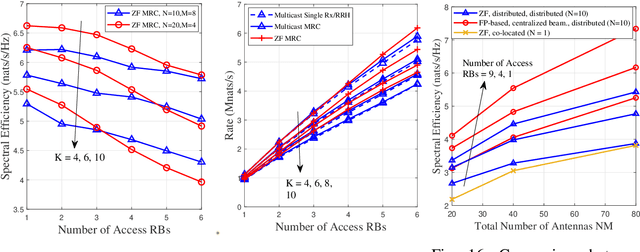
Abstract:We consider the analysis and design of distributed wireless networks wherein remote radio heads (RRHs) coordinate transmissions to serve multiple users on the same resource block (RB). Specifically, we analyze two possible multiple-input multiple-output wireless fronthaul solutions: multicast and zero forcing (ZF) beamforming. We develop a statistical model for the fronthaul rate and, coupled with an analysis of the user access rate, we optimize the placement of the RRHs. This model allows us to formulate the location optimization problem with a statistical constraint on fronthaul outage. Our results are cautionary, showing that the fronthaul requires considerable bandwidth to enable joint service to users. This requirement can be relaxed by serving a low number of users on the same RB. Additionally, we show that, with a fixed number of antennas, for the multicast fronthaul, it is prudent to concentrate these antennas on a few RRHs. However, for the ZF beamforming fronthaul, it is better to distribute the antennas on more RRHs. For the parameters chosen, using a ZF beamforming fronthaul improves the typical access rate by approximately 8% compared to multicast. Crucially, our work quantifies the effect of these fronthaul solutions and provides an effective tool for the design of distributed networks.
Distributed Resource Allocation Optimization for User-Centric Cell-Free MIMO Networks
Oct 15, 2021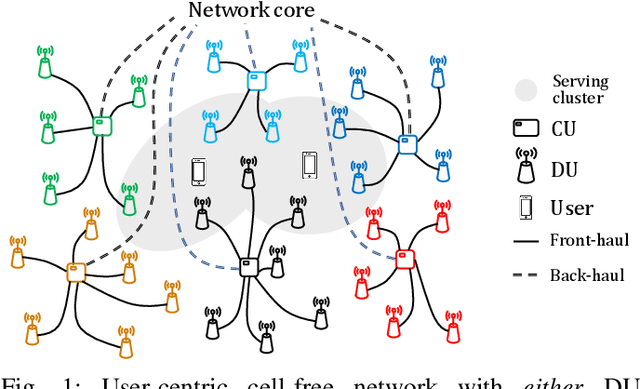
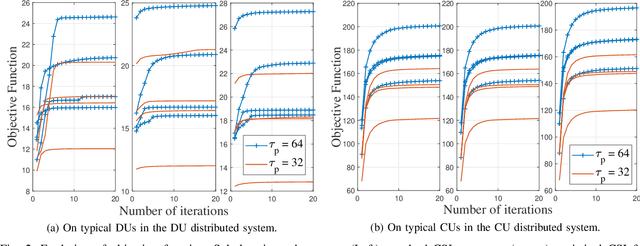

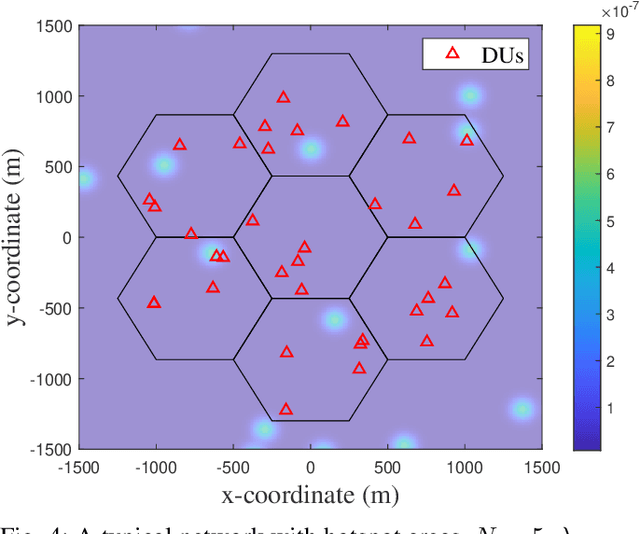
Abstract:We develop two distributed downlink resource allocation algorithms for user-centric, cell-free, spatially-distributed, multiple-input multiple-output (MIMO) networks. In such networks, each user is served by a subset of nearby transmitters that we call distributed units or DUs. The operation of the DUs in a region is controlled by a central unit (CU). Our first scheme is implemented at the DUs, while the second is implemented at the CUs controlling these DUs. We define a hybrid quality of service metric that enables distributed optimization of system resources in a proportional fair manner. Specifically, each of our algorithms performs user scheduling, beamforming, and power control while accounting for channel estimation errors. Importantly, our algorithm does not require information exchange amongst DUs (CUs) for the DU-distributed (CU-distributed) system, while also smoothly converging. Our results show that our CU-distributed system provides 1.3- to 1.8-fold network throughput compared to the DU-distributed system, with minor increases in complexity and front-haul load - and substantial gains over benchmark schemes like local zero-forcing. We also analyze the trade-offs provided by the CU-distributed system, hence highlighting the significance of deploying multiple CUs in user-centric cell-free networks.
Downlink Resource Allocation in Multiuser Cell-free MIMO Networks with User-centric Clustering
Aug 13, 2021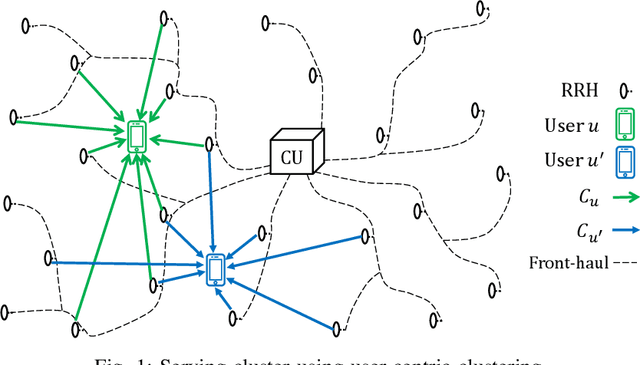
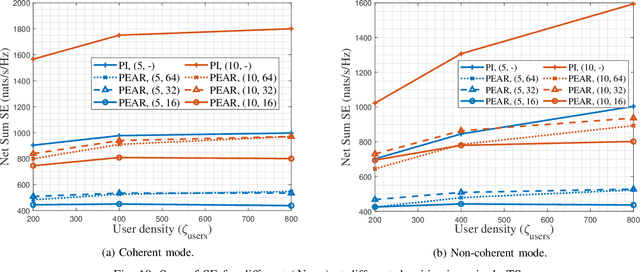
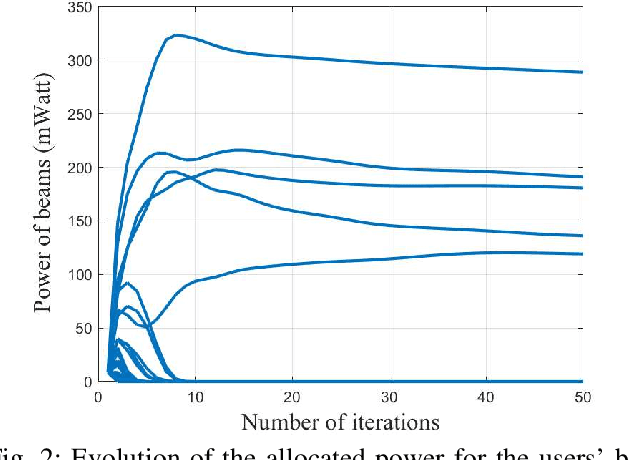
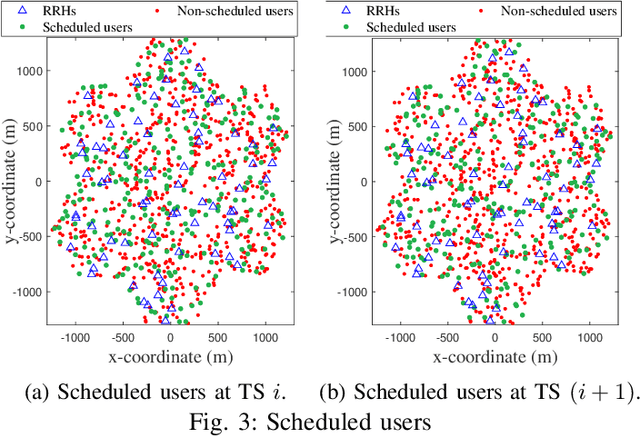
Abstract:In this paper, we optimize user scheduling, power allocation and beamforming in distributed multiple-input multiple-output (MIMO) networks implementing user-centric clustering. We study both the coherent and non-coherent transmission modes, formulating a weighted sum rate maximization problem for each; finding the optimal solution to these problems is known to be NP-hard. We use tools from fractional programming, block coordinate descent, and compressive sensing to construct an algorithm that optimizes the beamforming weights and user scheduling and converges in a smooth non-decreasing pattern. Channel state information (CSI) being crucial for optimization, we highlight the importance of employing a low-overhead pilot assignment policy for scheduling problems. In this regard, we use a variant of hierarchical agglomerative clustering, which provides a suboptimal, but feasible, pilot assignment scheme; for our cell-free case, we formulate an area-based pilot reuse factor. Our results show that our scheme provides large gains in the long-term network sum spectral efficiency compared to benchmark schemes such as zero-forcing and conjugate beamforming (with round-robin scheduling) respectively. Furthermore, the results show the superiority of coherent transmission compared to the non-coherent mode under ideal and imperfect CSI for the area-based pilot-reuse factors we consider.
User-centric Cell-free Massive MIMO Networks: A Survey of Opportunities, Challenges and Solutions
Apr 29, 2021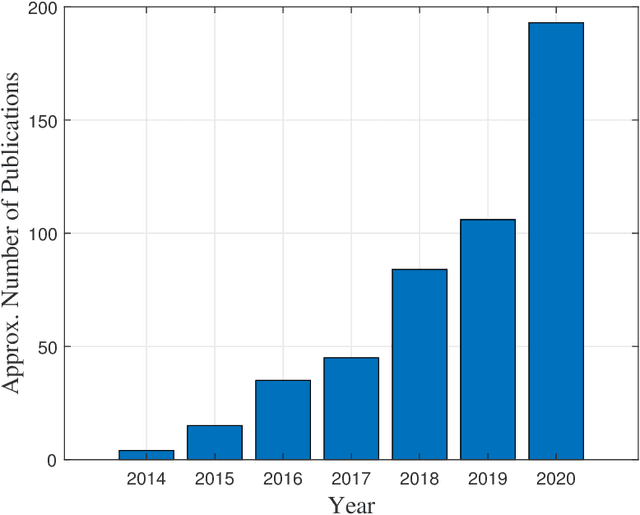
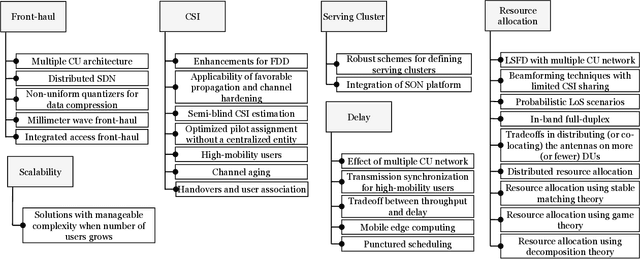
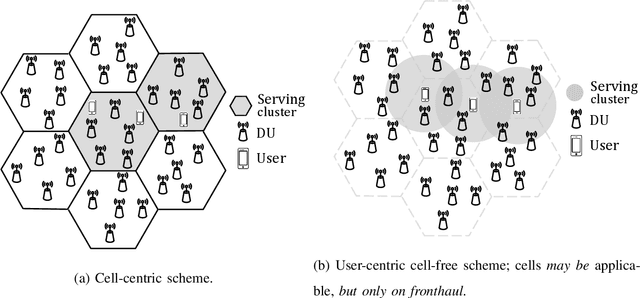
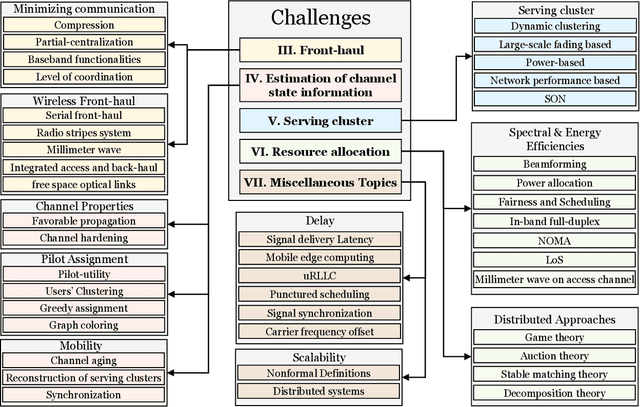
Abstract:Densification of network base stations is indispensable to achieve the stringent Quality of Service (QoS) requirements of future mobile networks. However, with a dense deployment of transmitters, interference management becomes an arduous task. To solve this issue, exploring radically new network architectures with intelligent coordination and cooperation capabilities is crucial. This survey paper investigates the emerging user-centric cell-free massive multiple-input multiple-output (MIMO) network architecture that sets a foundation for future mobile networks. Such networks use a dense deployment of distributed units (DUs) to serve users; the crucial difference from the traditional cellular paradigm is that a specific serving cluster of DUs is defined for each user. This framework provides macro diversity, power efficiency, interference management, and robust connectivity. Most importantly, the user-centric approach eliminates cell edges, thus contributing to uniform coverage and performance for users across the network area. We present here a guide to the key challenges facing the deployment of this network scheme and contemplate the solutions being proposed for the main bottlenecks facing cell-free communications. Specifically, we survey the literature targeting the fronthaul, then we scan the details of the channel estimation required, resource allocation, delay, and scalability issues. Furthermore, we highlight some technologies that can provide a management platform for this scheme such as distributed software-defined network (SDN) and self-organizing network (SON). Our article serves as a check point that delineates the current status and indicates future directions for this area in a comprehensive manner.
 Add to Chrome
Add to Chrome Add to Firefox
Add to Firefox Add to Edge
Add to Edge